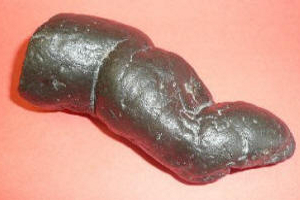Coprolites - Fossilised Dinosaur Dung

Coprolites Fossil Dung
Coprolites are fossiled dung, Fossil Faeces and as one of the jokes goes - Coprolite Happens! But how did it happen? How can so much Dinosaur and other dung get fossilised and mostly inside the animals?

Coprolite Happens
One explanation that would fit reality is if Coprolites were fossilised instantly along with the rest of the animal.
The info below is taken from
The Discovery of Coprolites (Fossil Dung) in the 19th Century | suite101.com
trace fossils - kopros lithos - ichnofossils (Coprolites)
English Cleric and Geologist William Buckland First Described These Trace Fossils in 1829Fossils may be divided into two basic types, body fossils and trace fossils. Body fossils represent remains that were once actual organic body parts of a creature, such as bones and teeth. Trace fossils, on the other hand, also known as ichnofossils (from the Greek word “ikhnos”, meaning "track" or "trace"), represent evidence of an organism’s activity. Examples include trackways, burrows and borings.
Another variety of trace fossil – coprolites – represents fossilized dung. They are typically contorted or nodular and can indicate features such as the parent creature’s diet. The true nature of coprolites weren’t realized until the late 1820s.

Mary Anning’s Fossil Depot (Coprolites)
Mary Anning Discovers Supposed Bezoar Stones in English Fossil DepositsMary Anning was an English fossil collector who made several important paleontological discoveries, such as the first plesiosaur skeletons and first correctly identified ichthyosaur skeleton. Living from 1799 to 1847, she spent her life collecting and selling fossils (at her shop, Anning’s Fossil Depot) near her home in Lyme Regis, a coastal town in West Dorset, England. She is believed to be the inspiration for Terry Sullivan’s 1908 tongue twister, “She Sells Seashells." It reads as follows: "She sells sea-shells on the sea-shore. / The shells she sells are sea-shells, I'm sure. / For if she sells sea-shells on the sea-shore / Then I'm sure she sells sea-shore shells."
By the late 1820s, Anning had established herself as a noteworthy fossil collector and knowledgeable paleontologist. In her diggings at Lyme Regis, she found numerous stony, potato-shaped objects, typically ranging in size from two to four inches long and half as wide.
Locals called these objects “bezoar stones” because they resembled the gallstones common in bezoar goats, ancestors to the domestic goat. At one time, bezoar stones were believed to have important medicinal values as poison antidotes. At Lyme Regis, Anning often found them in the abdominal regions of ichthyosaur skeletons. Furthermore, upon breaking open many of them, she found that they often contained bone fragments from such creatures as ichthyosaurs and fish.

William Buckland Fossil Faeces (Coprolites)
William Buckland Names and Describes CoprolitesBy the 1920s, English minister and geologist William Buckland had established himself as a leading authority on paleontology. For instance, he was the first person to scientifically describe a dinosaur, introducing Megalosaurus in 1824.
Like Anning, Buckland had also found objects resembling bezoar stones in fossil deposits. He visited with Anning and the two compared their fossils. Based on the content of the coprolites, plus their common proximity to the abdominal regions of skeletons, Buckland realized the true nature of the objects.
At a February 6, 1829 meeting of the Geological Society of London, Buckland described them and introduced the term coprolites (from the Greek words “kopros”, meaning "dung," and “lithos”, meaning "stone"). He then went on to describe coprolites found at other fossil localities around England and in several cases attributed them to specific animal types.